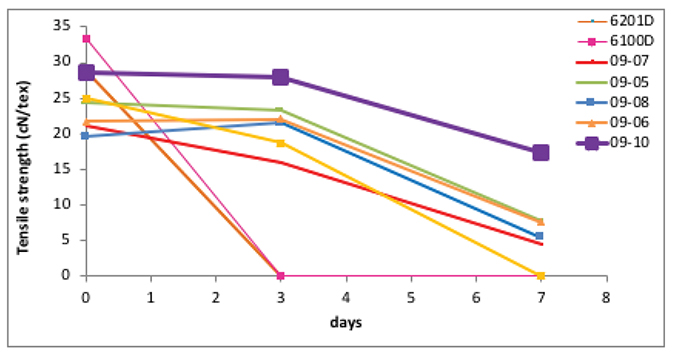Most fabrics currently available on the market are made of natural fibers, such as cotton and wool, and polyester (PES) blends. With the aim of finding a more sustainable material to produce clothing, polylactic acid (PLA) has been used to replace PES. PLA is biodegradable, compostable and obtained from renewable resources. It is also suitable for obtaining melt-processable fibers.
PLA’s chemical structure has demonstrated better breathability, hydrophilic properties, ultraviolet resistance, low smoke production and flammability, and lower density than PES.
Current limitations on commercial PLA grades for use in textile applications are based on their mechanical, thermal and hydrolytic behavior. The purpose of the FIBFAB project is to improve the behavior of PLA for use in clothing manufacture by developing a new bio-compound that provides the desired properties for clothing applications and is suitable for use in industrial fiber production.
FIBFAB, a 33-month project funded by the European Union’s Horizon 2020 Fast Track to Innovation pilot program, is coordinated by AIMPLAS, Plastics Technology Centre based in Paterna, Valencia, Spain. Together with the other members of the consortium – Centexbel, Yünsa and Sintex – the textile value chain is now covered from fiber production to product manufacture, thus ensuring capacity for industrial implementation of PLA fibers for clothing.
The FIBFAB project aims to industrialize the production of biodegradable and sustainable PLA-based fabrics (wool/PLA and cotton/PLA blends) for applications in casual wear, workwear and protective clothing, and to overcome current limitations of PLA fibers as a real alternative to existing fabrics.
The advantages of the project are based on:
- developing a final clothing product that is 100% bio-based and biodegradable and meets the mechanical performance requirements of the textile sector;
- introducing yarns and fabrics produced from PLA fibers, cotton and wool on the market;
- improving PLA fibers’ currently poor thermal resistance so they meet the requirement of washing clothing applications at 90 C;
- developing materials that are suitable for obtaining fine fibers, as well as the mechanical spinning process (friction control in ring spinning) to spin PLA fiber blends at higher speeds;
- reducing dependence on Asian countries, mainly PES suppliers, and improving the competitiveness of the textile industry by creating a new clothing concept that meets the expectations of environmentally aware customers;
- aligning European initiatives with the use of recycled, recyclable and sustainable materials for textile applications.
The FIBFAB project ended in September 2019. In the final months, the project consortium worked on optimizing new compound properties to be used in clothing applications.
Work focused primarily on the suitability of the material for the melt spinning processes and scaling up industrial processes to achieve fineness and property levels to guarantee further processing for yarn spinning and fabric manufacture.
Project results show that PLA staple fibers with improved properties can be obtained on an industrial staple fiber line. The fibers meet the requirements of these applications in terms of mechanical properties, shrinkage, titer and crimp. These fibers are now being evaluated for yarn spinning in combination with cotton and wool.
AIMPLAS is the main party responsible for developing the new compound, which contains a mix of different commercial PLA fibers and additives, such as nucleants, processing aids and hydrolytic stabilizers.
A co-rotating twin screw extruder is used to obtain new PLA-based pellets with improved properties (Figure 1).

The compounds developed were characterized based on results. Target objectives were achieved regarding viscosity, thermal resistance, crystallinity, hydrolytic behavior, mechanical properties and shrinkage (at 100 C), as well as the ability to process and obtain fibers of less than 3 dtex.
In the hydrolytic stabilization study, the developed materials’ mechanical properties were measured after several washing and drying cycles. The results are shown in Figure 2.

Based on these results, a suitable formulation was achieved, and the compound maintained good properties after several days of washing and drying for use in clothing applications. This compound was selected to develop fibers and fabrics.
Table 1 compares some commercial PLAs and the selected FIBFAB compound in terms of the main properties studied.
|
Material |
MFI (g/10 min) 210 C, 2.16 kg |
VICAT B50 (ºC) | Crystallinity (%) |
Mechanical properties after washing cycles (cN/tex) | |
| Before | After1 | ||||
| Target properties | 15-30 | >90 | 40 | – | 15 |
| PLA 6201 D | 25 | 55-60 | 25 | 29 | 0 |
| PLA 6100 D | 24 | 55-60 | – | 34 | 0 |
| Selected FIBFAB compound | 23 | 93 | 47 | 29 | 18 |
1 washing and drying cycles
Table 1. Comparison of commercial PLAs and the selected compound in terms of the main properties studied.
Because all the results of the properties measured on the selected compound were positive, different fibers, yarns and final products such as T-shirts were obtained using this new material.

The FIBFAB project also considered European regulations on the use of sustainable materials in textile applications. In countries such as France, studies are being prepared on the market for bio-based products to better understand the conditions that facilitate the selection of bio-based products in green public procurement (GPP).
The FIBFAB project applied EU GPP criteria when manufacturing these new products. These criteria have been developed to facilitate the inclusion of green requirements in public tender documents to achieve a good balance between environmental performance, cost considerations, market availability and ease of verification.
Final actions
In the final months of the project, partners focused on industrial scale-up processes to market these newly developed fabrics. Garments such as T-shirts were distributed to fair and exhibition visitors to find out their opinion about the new material.


